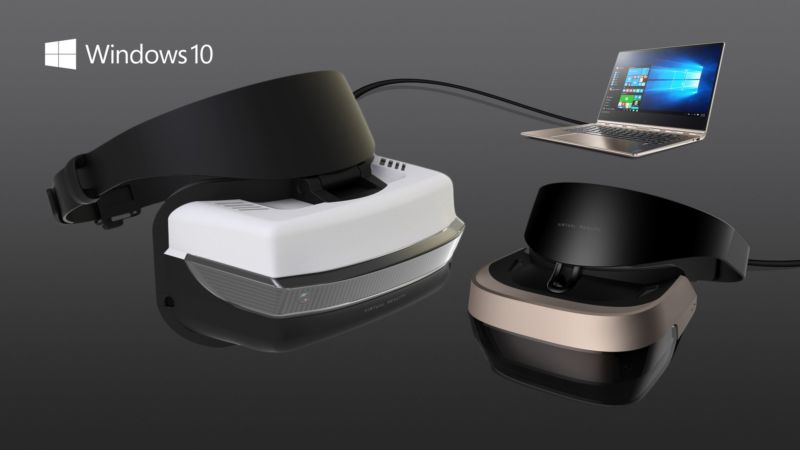
In all the discussion of virtual reality over the last couple of years, one company with a strong presence in both PC and console gaming has been conspicuously absent: Microsoft. Microsoft owns the PC platform that the high-end VR headsets (Facebook's Oculus Rift, HTC's Vive) run on, and while the Xbox One is in second place in the living room, it's nonetheless a major gaming platform. Yet when asked about its VR plans, the company had nothing to say; the closest thing to any involvement was bundling Xbox controllers with the Rift.
Even more peculiarly, Microsoft did nonetheless claim to have ambitions in the VR space. In June, the company said that Windows Holographic, the variant used on the HoloLens augmented reality headset, would be made available for third-party hardware, both VR and AR. In August, the company went a step further, saying that a 2017 update to Windows 10 would put these 3D features into the standard Windows 10 desktop system.
It turns out that that's just the start of it. This update, which will be called the Creators Update, contains a ton of 3D functionality. At its presentation yesterday, Microsoft demonstrated scanning physical objects on a phone, creating 3D scenes in a new Paint 3D application, 3D printing them, and viewing them on AR and VR headsets. 3D creation is being pushed to the foreground.
This is a big change, but it feels like a strange one: there's basically nobody who owns the Oculus Rift or the Vive. VR may have parts of the gaming community salivating, and it might yet be the Next Big Thing, but its market penetration is negligible right now. These PC headsets are both expensive and have substantial space and PC performance demands. They're also annoying to set up, requiring not just the headsets themselves, but motion tracking cameras or sensors for so-called "room-scale VR."But Microsoft also offered a way by which VR might become much more widespread and much simpler to boot. Though the company spent surprisingly little time on it, it announced that HP, Dell, Lenovo, Asus, and Acer would all be producing VR headsets of their own. On top of having built-in operating system support, these headsets would have two key advantages over current hardware.
First, they'd start out relatively cheap at $299. We don't know exactly what performance and visual quality we'll be getting for $299, of course, but that's a competitive price. The Oculus Rift is $599, and the HTC Vive is $799. Even the PlayStation VR is $399—$299 threatens to undercut all of those, substantially.
Second, these headsets would do away with the complex setup, removing the need for motion tracking boxes. Current headsets include 3-axis sensors that can detect rotation around their three dimensions. They can't, however, detect translations in any direction. This is what the motion boxes are for; they can detect motion through space and allow moving around virtual environments. This new generation of headsets will include six-degree-of-freedom motion sensing, tracking both rotation and translation directly from the headset itself. This in turn does away with the need for the motion boxes, making installation much easier and more flexible. You can use them in any room in your home (or office) without having to worry about going out of range of the boxes.
Six-degree-of-freedom sensing is also a really hard problem to solve without external references, and the technique being used remains unknown. HoloLens, with its array of sensors, can achieve it, but the VR headsets Microsoft has pictured don't immediately appear to have HoloLens' complexity.
There's still a lot unknown about Microsoft's plans. Performance, visual quality, and GPU requirements are all major unknowns, and the GPU demands in particular are sufficient to keep current PC VR headsets away from mainstream audiences. Also missing from the announcement were the existing PC VR companies. This is perhaps unsurprising in the case of HTC since its software partner, Valve, has a fractious relationship with Microsoft already. Valve is unlikely to appreciate Redmond's attempt to further encroach on its turf. But Oculus' absence was a little more surprising given that the companies have appeared on stage together in the past. Perhaps the relationship between Microsoft and these companies will become clearer as we learn more of what the Windows VR platform will really be.
With this combination of software and (third-party) hardware, Microsoft looks like it could, within the span of a few months, go from being a complete non-player in the VR space to a major platform owner. It looks like the company really did have a plan for VR all along—it was just taking its time to talk about it.
reader comments
98